Low-Threshold and High-Extinction-Ratio Optical Bistability within a Graphene-Based Perfect Absorber
Abstract
1. Introduction
2. Model and Methods
3. Results and Discussion
4. Conclusions
Author Contributions
Funding
Institutional Review Board Statement
Informed Consent Statement
Data Availability Statement
Conflicts of Interest
References
- Tan, Y.; Xia, X.-S.; Liao, X.-L.; Li, J.-B.; Zhong, H.-H.; Liang, S.; Xiao, S.; Liu, L.-H.; Luo, J.-H.; He, M.-D.; et al. A highly-flexible bistable switch based on a suspended monolayer Z-shaped graphene nanoribbon nanoresonator. Carbon 2020, 157, 724–730. [Google Scholar] [CrossRef]
- Mazurenko, D.A.; Kerst, R.; Dijkhuis, J.I.; Akimov, A.V.; Golubev, V.G.; Kurdyukov, D.A.; Pevtsov, A.B.; Sel’Kin, A.V. Ultrafast Optical Switching in Three-Dimensional Photonic Crystals. Phys. Rev. Lett. 2003, 91, 213903. [Google Scholar] [CrossRef] [PubMed]
- Chang, H.; Wu, H.; Xie, C.; Wang, H. Controlled Shift of Optical Bistability Hysteresis Curve and Storage of Optical Signals in a Four-Level Atomic System. Phys. Rev. Lett. 2004, 93, 213901. [Google Scholar] [CrossRef]
- Mavrogordatos, T.K.; Tancredi, G.; Elliott, M.; Peterer, M.J.; Patterson, A.; Rahamim, J.; Leek, P.J.; Ginossar, E.; Szymańska, M.H. Simultaneous Bistability of a Qubit and Resonator in Circuit Quantum Electrodynamics. Phys. Rev. Lett. 2017, 118, 040402. [Google Scholar] [CrossRef]
- Dutta, S.; Rangwala, S.A. All-optical switching in a continuously operated and strongly coupled atom-cavity system. Appl. Phys. Lett. 2017, 110, 121107. [Google Scholar] [CrossRef]
- Guo, K.; Yang, L.; Shi, X.; Liu, X.; Cao, Y.; Zhang, J.; Wang, X.; Yang, J.; Ou, H.; Zhao, Y. Nonclassical Optical Bistability and Resonance-Locked Regime of Photon-Pair Sources Using Silicon Microring Resonator. Phys. Rev. Appl. 2019, 11, 034007. [Google Scholar] [CrossRef]
- Li, J.; Lü, X.; Luo, J.; Huang, Q. Optical bistability and multistability via atomic coherence in an N-type atomic medium. Phys. Rev. A 2006, 74, 035801. [Google Scholar] [CrossRef]
- Joshi, A.; Brown, A.; Wang, H.; Xiao, M. Controlling optical bistability in a three-level atomic system. Phys. Rev. A 2003, 67, 041801(R). [Google Scholar] [CrossRef]
- Shinya, A.; Mitsugi, S.; Tanabe, T.; Notomi, M.; Yokohama, I.; Takara, H.; Kawanishi, S. All-optical flip-flop circuit composed of coupled two-port resonant tunneling filter in two-dimensional photonic crystal slab. Opt. Express 2006, 14, 1230–1235. [Google Scholar] [CrossRef]
- Haret, L.-D.; Tanabe, T.; Kuramochi, E.; Notomi, M. Extremely low power optical bistability in silicon demonstrated using 1D photonic crystal nanocavity. Opt. Express 2009, 17, 21108–21117. [Google Scholar] [CrossRef]
- Song, G.; Yu, L.; Wu, C.; Duan, G.; Wang, L.; Xiao, J. Polarization Splitter with Optical Bistability in Metal Gap Waveguide Nanocavities. Plasmonics 2013, 8, 943–947. [Google Scholar] [CrossRef]
- Hamidi, S.M.; Eslamiat, Z. Optical bistability in one-dimensional coupled resonator nonlinear optical waveguide. J. Nonlinear Opt. Phys. Mater. 2013, 22, 1350003. [Google Scholar] [CrossRef]
- Gan, X.; Shiue, R.-J.; Gao, Y.; Meric, I.; Heinz, T.F.; Shepard, K.; Hone, J.; Assefa, S.; Englund, D. Chip-integrated ultrafast graphene photodetector with high responsivity. Nat. Photon. 2013, 7, 883–887. [Google Scholar] [CrossRef]
- Fan, Y.; Zhang, Z.; Zhu, Z.; Zhang, J.; Xu, W.; Wu, F.; Yuan, X.; Guo, C.; Qin, S. Regulation of Thermal Emission Position in Biased Graphene. Nanomaterials 2022, 12, 3457. [Google Scholar] [CrossRef]
- Zhang, H.; Virally, S.; Bao, Q.; Ping, L.K.; Massar, S.; Godbout, N.; Kockaert, P. Z-scan measurement of the nonlinear refractive index of graphene. Opt. Lett. 2012, 37, 1856–1858. [Google Scholar] [CrossRef]
- Miao, L.; Jiang, Y.; Lu, S.; Shi, B.; Zhao, C.; Zhang, H.; Wen, S. Broadband ultrafast nonlinear optical response of few-layers graphene: Toward the mid-infrared regime. Photon. Res. 2015, 3, 214–219. [Google Scholar] [CrossRef]
- Liu, K.; Zhang, J.F.; Xu, W.; Zhu, Z.H.; Guo, C.C.; Li, X.J.; Qin, S.Q. Ultra-fast pulse propagation in nonlinear graphene/silicon ridge waveguide. Sci. Rep. 2015, 5, 16734. [Google Scholar] [CrossRef]
- Zou, X.; Zheng, G.; Cong, J.; Xu, L.; Chen, Y.; Lai, M. Polarization-insensitive and wide-incident-angle optical absorber with periodically patterned graphene-dielectric arrays. Opt. Lett. 2018, 43, 46–49. [Google Scholar] [CrossRef] [PubMed]
- Li, Q.; Lu, J.; Gupta, P.; Qiu, M. Engineering Optical Absorption in Graphene and Other 2D Materials: Advances and Applications. Adv. Opt. Mater. 2019, 7, 1900595. [Google Scholar] [CrossRef]
- Zhang, X.; John, S. Broadband light-trapping enhancement of graphene absorptivity. Phys. Rev. B 2019, 99, 035417. [Google Scholar] [CrossRef]
- Qing, Y.M.; Ma, H.F.; Ren, Y.Z.; Yu, S.; Cui, T.J. Near-infrared absorption-induced switching effect via guided mode resonances in a graphene-based metamaterial. Opt. Express 2019, 27, 5253–5263. [Google Scholar] [CrossRef]
- Wang, J.; Chen, A.; Zhang, Y.; Zeng, J.; Zhang, Y.; Liu, X.; Shi, L.; Zi, J. Manipulating bandwidth of light absorption at critical coupling: An example of graphene integrated with dielectric photonic structure. Phys. Rev. B 2019, 100, 075407. [Google Scholar] [CrossRef]
- Park, K.; Park, G.C. Tunable dual-wavelength absorption switch with graphene based on asymmetric guided-mode resonance structure. Opt. Express 2021, 29, 7307–7320. [Google Scholar] [CrossRef]
- Xiao, S.; Liu, T.; Wang, X.; Liu, X.; Zhou, C. Tailoring the absorption bandwidth of graphene at critical coupling. Phys. Rev. B 2020, 102, 085410. [Google Scholar] [CrossRef]
- Nematpour, A.; Lisi, N.; Lancellotti, L.; Chierchia, R.; Grilli, M.L. Experimental Mid-Infrared Absorption (84%) of Single-Layer Graphene in a Reflective Asymmetric Fabry–Perot Filter: Implications for Photodetectors. ACS Appl. Nano Mater. 2021, 4, 1495–1502. [Google Scholar] [CrossRef]
- Yan, Z.; Gao, L.; Tang, C.; Lv, B.; Gu, P.; Chen, J.; Zhu, M. Simultaneously achieving narrowband and broadband light absorption enhancement in monolayer graphene. Diam. Relat. Mater. 2022, 126, 109122. [Google Scholar] [CrossRef]
- Piper, J.R.; Fan, S. Total Absorption in a Graphene Monolayer in the Optical Regime by Critical Coupling with a Photonic Crystal Guided Resonance. ACS Photon. 2014, 1, 347–353. [Google Scholar] [CrossRef]
- Grande, M.; Vincenti, M.A.; Stomeo, T.; Bianco, G.V.; de Ceglia, D.; Aközbek, N.; Petruzzelli, V.; Bruno, G.; De Vittorio, M.; Scalora, M.; et al. Graphene-based perfect optical absorbers harnessing guided mode resonances. Opt. Express 2015, 23, 21032–21042. [Google Scholar] [CrossRef]
- Guo, C.; Zhu, Z.; Yuan, X.; Ye, W.; Liu, K.; Zhang, J.; Xu, W.; Qin, S. Experimental Demonstration of Total Absorption over 99% in the Near Infrared for Monolayer-Graphene-Based Subwavelength Structures. Adv. Opt. Mater. 2016, 4, 1955–1960. [Google Scholar] [CrossRef]
- Fan, Y.S.; Guo, C.C.; Zhu, Z.H.; Xu, W.; Wu, F.; Yuan, X.D.; Qin, S.Q. Monolayer-graphene-based perfect absorption structures in the near infrared. Opt. Express 2017, 25, 13079–13086. [Google Scholar] [CrossRef]
- Jiang, X.; Wang, T.; Xiao, S.; Yan, X.; Cheng, L. Tunable ultra-high-efficiency light absorption of monolayer graphene using critical coupling with guided resonance. Opt. Express 2017, 25, 27028–27036. [Google Scholar] [CrossRef]
- Lee, S.; Song, J.; Kim, S. Graphene perfect absorber design based on an approach of mimicking a one-port system in an asymmetric single resonator. Opt. Express 2021, 29, 29631. [Google Scholar] [CrossRef]
- Sang, T.; Dereshgi, S.; Hadibrata, W.; Tanriover, I.; Aydin, K. Highly Efficient Light Absorption of Monolayer Graphene by Quasi-Bound State in the Continuum. Nanomaterials 2021, 11, 484. [Google Scholar] [CrossRef]
- Asgari, S.; Fabritius, T. Graphene-based dual-functional chiral metamirror composed of complementary 90° rotated U-shaped resonator arrays and its equivalent circuit model. Sci. Rep. 2021, 11, 23827. [Google Scholar] [CrossRef]
- Kim, S.; Jang, M.S.; Brar, V.W.; Mauser, K.W.; Kim, L.; Atwater, H.A. Electronically Tunable Perfect Absorption in Graphene. Nano Lett. 2018, 18, 971–979. [Google Scholar] [CrossRef]
- Guo, C.; Zhang, J.; Xu, W.; Liu, K.; Yuan, X.; Qin, S.; Zhu, Z. Graphene-Based Perfect Absorption Structures in the Visible to Terahertz Band and Their Optoelectronics Applications. Nanomaterials 2018, 8, 1033. [Google Scholar] [CrossRef]
- Chen, J.; Chen, S.; Gu, P.; Yan, Z.; Tang, C.; Xu, Z.; Liu, B.; Liu, Z. Electrically modulating and switching infrared absorption of monolayer graphene in metamaterials. Carbon 2020, 162, 187–194. [Google Scholar] [CrossRef]
- Chen, Y.; Fan, Y.; Zhang, Z.; Zhu, Z.; Liu, K.; Zhang, J.; Xu, W.; Yuan, X.; Guo, C. High resolution graphene angle sensor based on ultra-narrowband optical perfect absorption. Opt. Express 2021, 29, 41206–41212. [Google Scholar] [CrossRef]
- Nong, J.; Feng, F.; Gan, J.; Min, C.; Yuan, X.; Somekh, M. Active Modulation of Graphene Near-Infrared Electroabsorption Employing Borophene Plasmons in a Wide Waveband. Adv. Opt. Mater. 2022, 10, 2102131. [Google Scholar] [CrossRef]
- Guo, J.; Jiang, L.; Jia, Y.; Dai, X.; Xiang, Y.; Fan, D. Low threshold optical bistability in one-dimensional gratings based on graphene plasmonics. Opt. Express 2017, 25, 5972–5981. [Google Scholar] [CrossRef]
- Guo, J.; Ruan, B.; Zhu, J.; Dai, X.; Xiang, Y.; Zhang, H. Low-threshold optical bistability in a metasurface with graphene. J. Phys. D Appl. Phys. 2017, 50, 434003. [Google Scholar] [CrossRef]
- Jiang, L.; Tang, J.; Xu, J.; Zheng, Z.; Dong, J.; Guo, J.; Qian, S.; Dai, X.; Xiang, Y. Graphene Tamm plasmon-induced low-threshold optical bistability at terahertz frequencies. Opt. Mater. Express 2019, 9, 139–150. [Google Scholar] [CrossRef]
- Peng, Y.; Xu, J.; Dong, H.; Dai, X.; Jiang, J.; Qian, S.; Jiang, L. Graphene-based low-threshold and tunable optical bistability in one-dimensional photonic crystal Fano resonance heterostructure at optical communication band. Opt. Express 2020, 28, 34948–34959. [Google Scholar] [CrossRef]
- Xu, H.; Qin, Z.; Liu, F.; Zhong, D.; Ni, H.; Liu, P. Optical bistability of graphene in PT2symmetric Thue–Morse photonic crystals. J. Mater. Sci. 2022, 57, 6524–6535. [Google Scholar] [CrossRef]
- Wang, J.; Xu, F.; Liu, F.; Zhao, D. Optical bistable and multistable phenomena in aperiodic multilayer structures with graphene. Opt. Mater. 2021, 119, 111395. [Google Scholar] [CrossRef]
- Yuan, H.; Long, X.; Zhang, H.; Jiang, L.; Miao, S.; Xiang, Y. Tunable optical bistability based on Bloch surface waves in one-dimensional photonic crystal with graphene. Opt. Commun. 2022, 521, 128567. [Google Scholar] [CrossRef]
- Deng, H.; Ji, C.; Zhang, X.; Chen, P.; Wu, L.; Jiang, J.; Tian, H.; Jiang, L. Low threshold optical bistability in graphene/waveguide hybrid structure at terahertz frequencies. Opt. Commun. 2021, 499, 127282. [Google Scholar] [CrossRef]
- Tohari, M. Terahertz Optical Bistability in the Metal Nanoparticles-Graphene Nanodisks-Quantum Dots Hybrid Systems. Nanomaterials 2020, 10, 2173. [Google Scholar] [CrossRef]
- Li, X.; Tan, Y.; Yin, L.; Huo, Y.; Zhao, L.; Yue, Q.; Ning, T. Bistability of optical harmonic generation in monolayer graphene plasmonics. Opt. Lett. 2021, 46, 1029–1032. [Google Scholar] [CrossRef]
- Xiang, Y.; Dai, X.; Guo, J.; Wen, S.; Tang, D. Tunable optical bistability at the graphene-covered nonlinear interface. Appl. Phys. Lett. 2014, 104, 051108. [Google Scholar] [CrossRef]
- Ahn, K.J.; Rotermund, F. Terahertz optical bistability of graphene in thin layers of dielectrics. Opt. Express 2017, 25, 8484–8490. [Google Scholar] [CrossRef] [PubMed]
- Sanderson, M.; Ang, Y.S.; Gong, S.; Zhao, T.; Hu, M.; Zhong, R.; Chen, X.; Zhang, P.; Zhang, C.; Liu, S. Optical bistability induced by nonlinear surface plasmon polaritons in graphene in terahertz regime. Appl. Phys. Lett. 2015, 107, 203113. [Google Scholar] [CrossRef]
- Gu, T.; McMillan, J.F.; Petrone, N.W.; van der Zande, A.; Hone, J.C.; Yu, M.; Lo, G.-Q.; Kwong, D.-L.; Wong, C.W. Optical bistability and free carrier dynamics in graphene–silicon photonic crystal cavities. Opt. Commun. 2014, 314, 23–27. [Google Scholar] [CrossRef]
- Huang, Y.; Miroshnichenko, A.; Gao, L. Low-threshold optical bistability of graphene-wrapped dielectric composite. Sci. Rep. 2016, 6, 23354. [Google Scholar] [CrossRef] [PubMed]
- De Abajo, F.J.G. Graphene Plasmonics: Challenges and Opportunities. ACS Photon. 2014, 1, 135–152. [Google Scholar] [CrossRef]
- Cox, J.D.; de Abajo, F.J.G. Nonlinear Graphene Nanoplasmonics. Acc. Chem. Res. 2019, 52, 2536–2547. [Google Scholar] [CrossRef]
- Chen, X.; Zhang, J.; Wen, C.; Liu, K.; Zhu, Z.; Qin, S.; Yuan, X. Optical nonlinearity and non-reciprocal transmission of graphene integrated metasurface. Carbon 2021, 173, 126–134. [Google Scholar] [CrossRef]
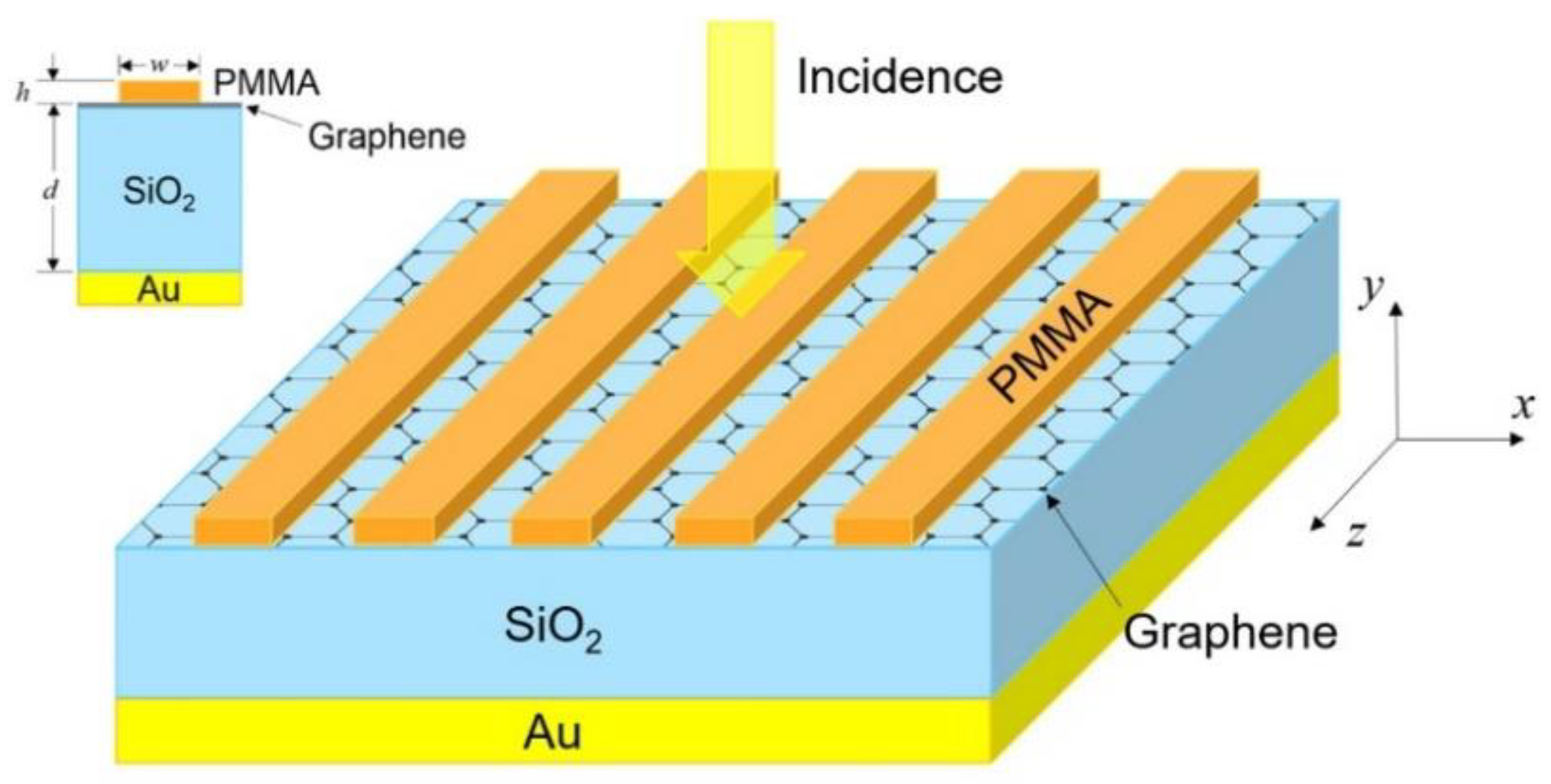

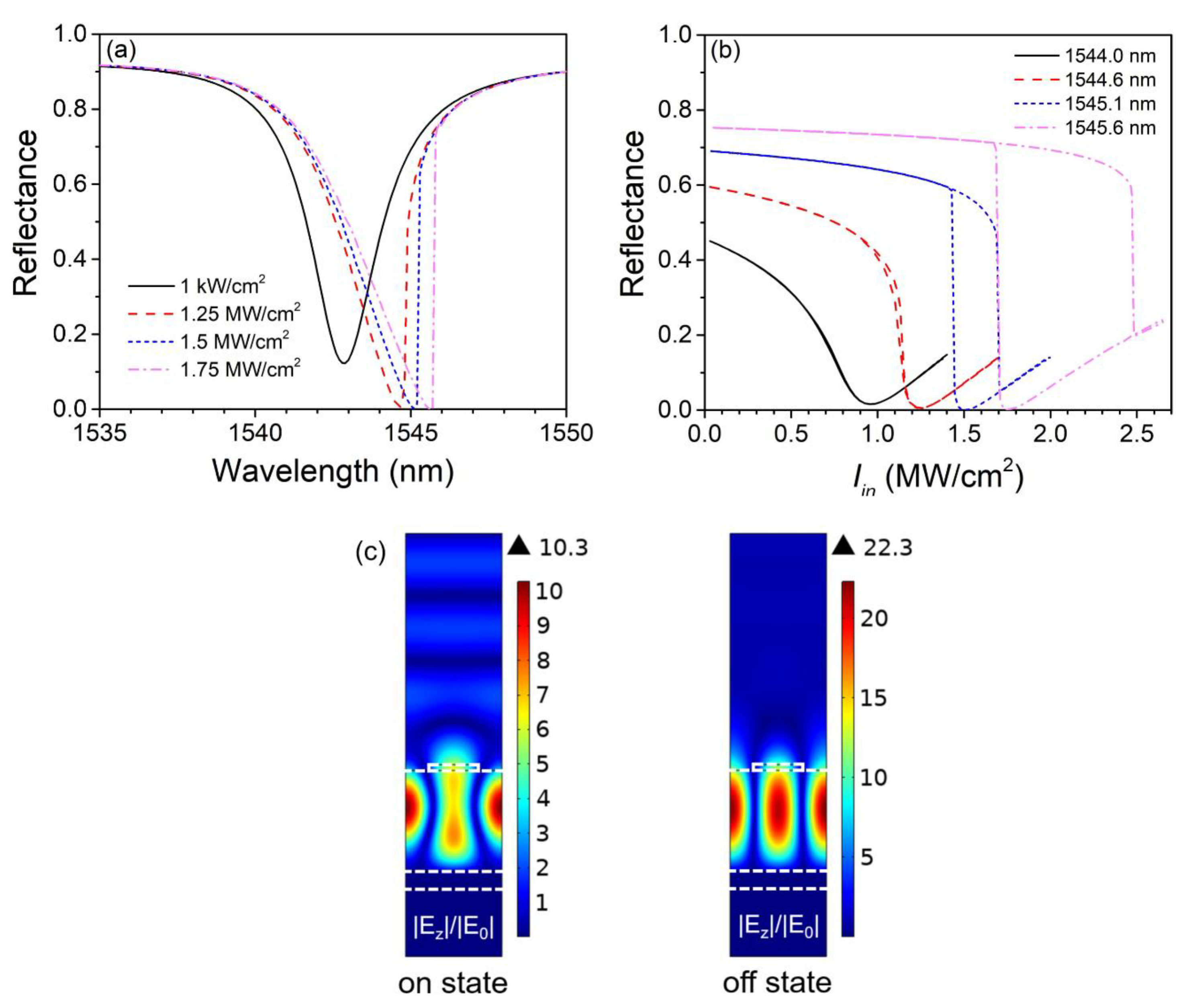
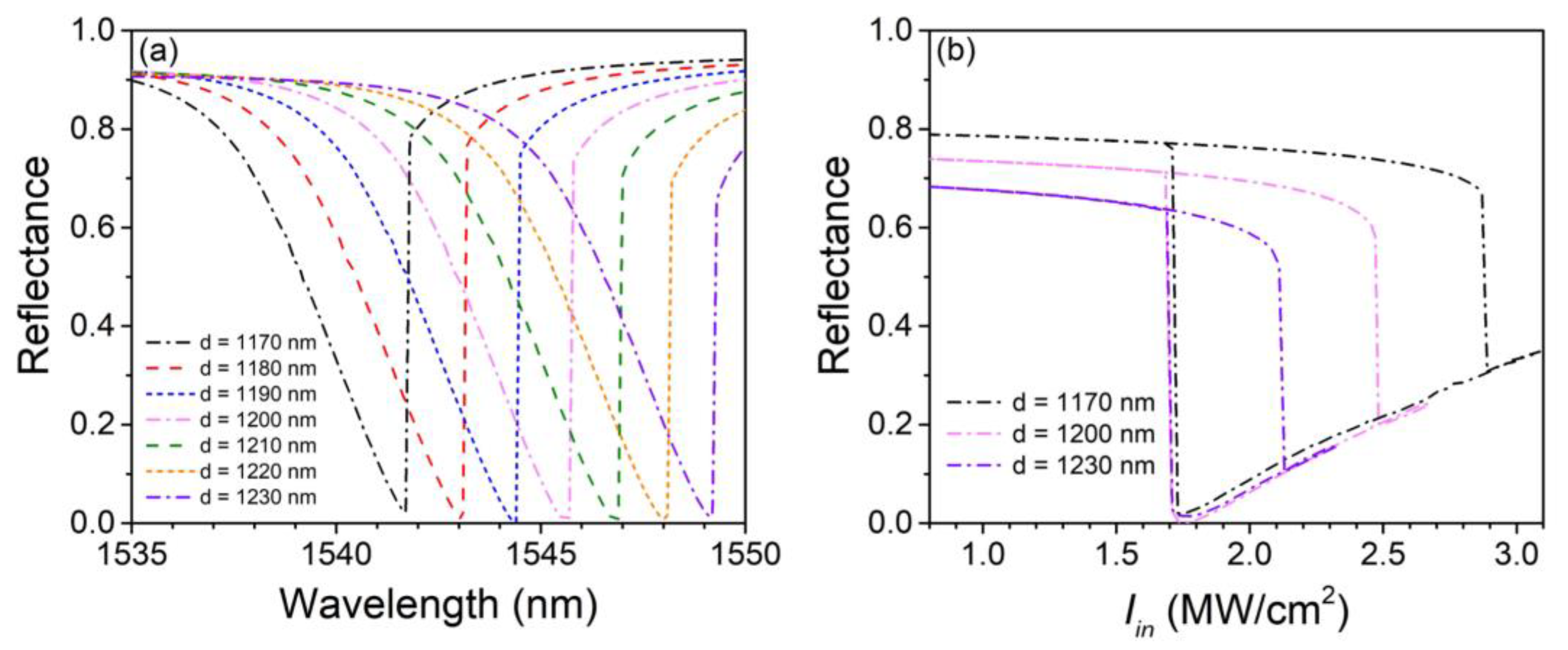
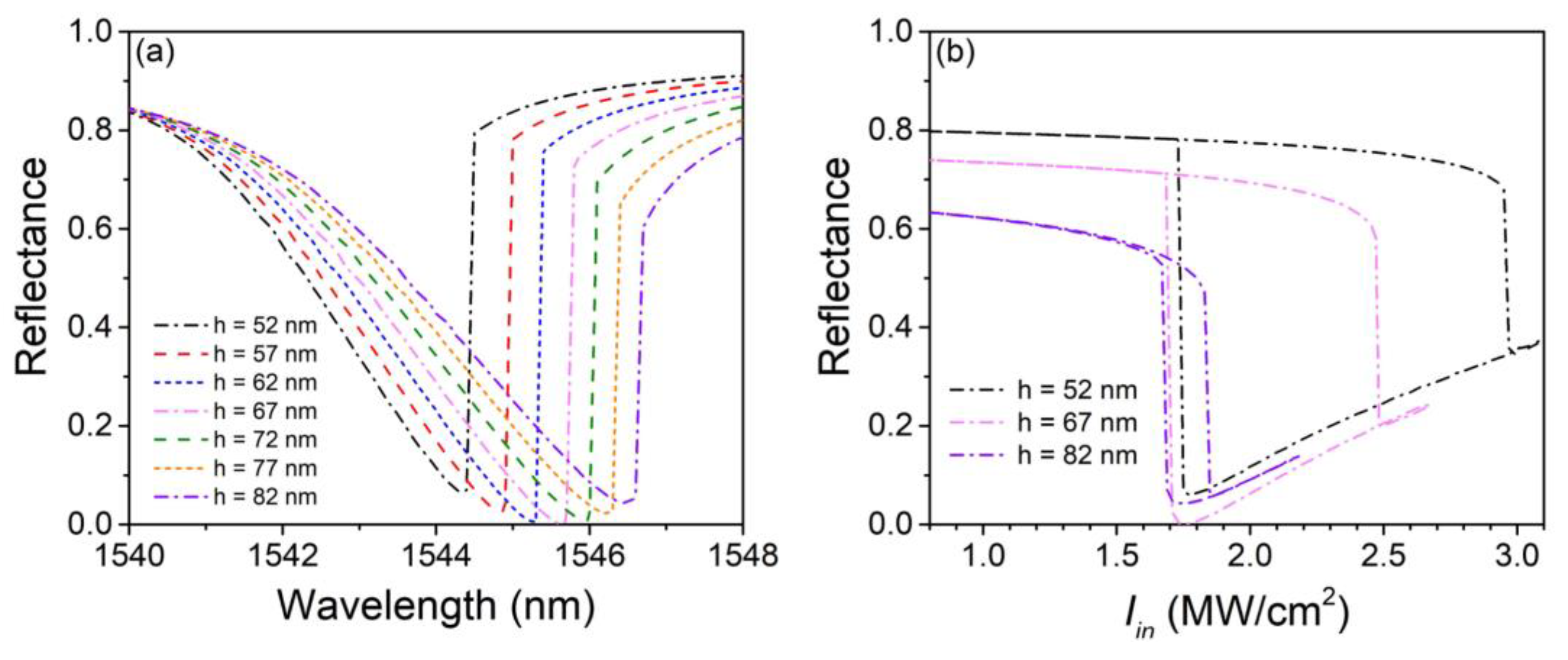
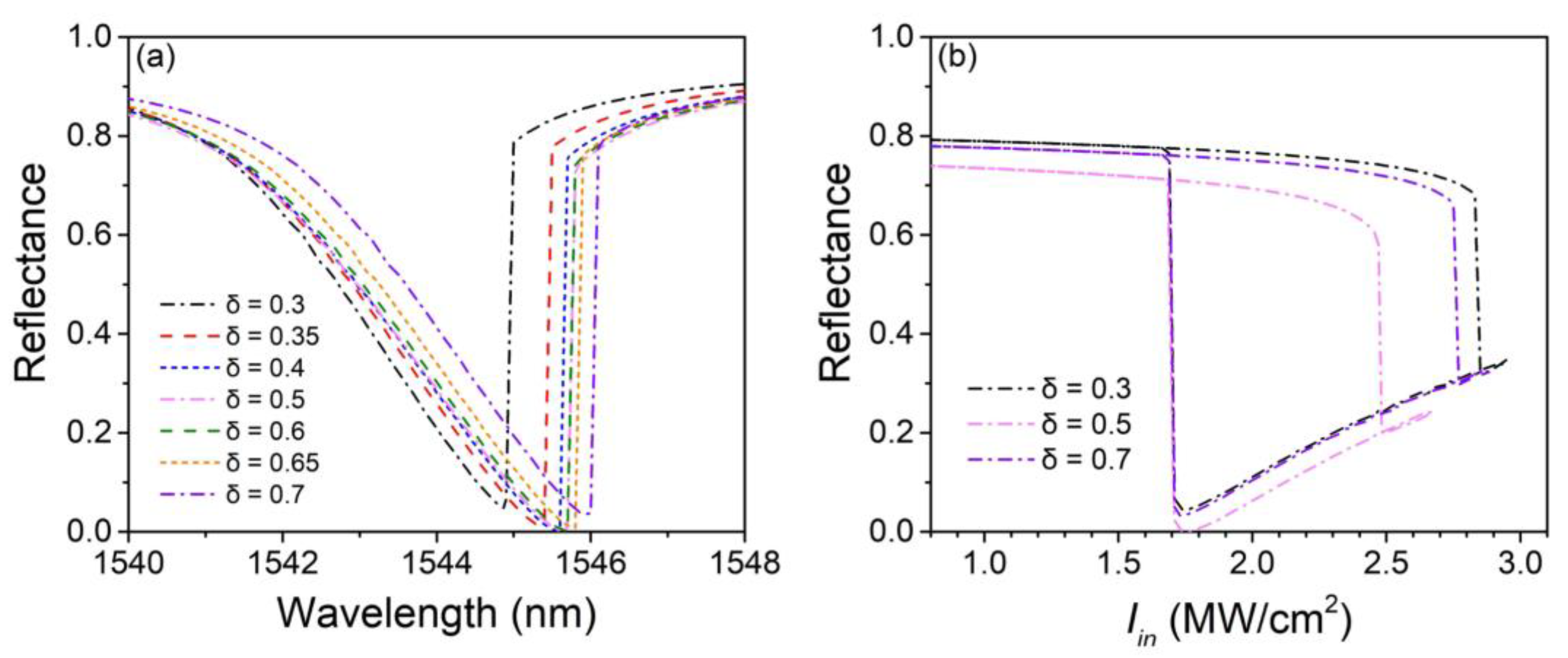
Disclaimer/Publisher’s Note: The statements, opinions and data contained in all publications are solely those of the individual author(s) and contributor(s) and not of MDPI and/or the editor(s). MDPI and/or the editor(s) disclaim responsibility for any injury to people or property resulting from any ideas, methods, instructions or products referred to in the content. |
© 2023 by the authors. Licensee MDPI, Basel, Switzerland. This article is an open access article distributed under the terms and conditions of the Creative Commons Attribution (CC BY) license (https://creativecommons.org/licenses/by/4.0/).
Share and Cite
Zhang, Z.; Sun, Q.; Fan, Y.; Zhu, Z.; Zhang, J.; Yuan, X.; Guo, C. Low-Threshold and High-Extinction-Ratio Optical Bistability within a Graphene-Based Perfect Absorber. Nanomaterials 2023, 13, 389. https://doi.org/10.3390/nano13030389
Zhang Z, Sun Q, Fan Y, Zhu Z, Zhang J, Yuan X, Guo C. Low-Threshold and High-Extinction-Ratio Optical Bistability within a Graphene-Based Perfect Absorber. Nanomaterials. 2023; 13(3):389. https://doi.org/10.3390/nano13030389
Chicago/Turabian StyleZhang, Zhengzhuo, Qiaoge Sun, Yansong Fan, Zhihong Zhu, Jianfa Zhang, Xiaodong Yuan, and Chucai Guo. 2023. "Low-Threshold and High-Extinction-Ratio Optical Bistability within a Graphene-Based Perfect Absorber" Nanomaterials 13, no. 3: 389. https://doi.org/10.3390/nano13030389
APA StyleZhang, Z., Sun, Q., Fan, Y., Zhu, Z., Zhang, J., Yuan, X., & Guo, C. (2023). Low-Threshold and High-Extinction-Ratio Optical Bistability within a Graphene-Based Perfect Absorber. Nanomaterials, 13(3), 389. https://doi.org/10.3390/nano13030389







